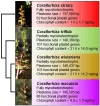Evolution of Whirly1 in the angiosperms: sequence, splicing, and expression in a clade of early transitional mycoheterotrophic orchids
- PMID: 39006962
- PMCID: PMC11239579
- DOI: 10.3389/fpls.2024.1241515
Evolution of Whirly1 in the angiosperms: sequence, splicing, and expression in a clade of early transitional mycoheterotrophic orchids
Abstract
The plastid-targeted transcription factor Whirly1 (WHY1) has been implicated in chloroplast biogenesis, plastid genome stability, and fungal defense response, which together represent characteristics of interest for the study of autotrophic losses across the angiosperms. While gene loss in the plastid and nuclear genomes has been well studied in mycoheterotrophic plants, the evolution of the molecular mechanisms impacting genome stability is completely unknown. Here, we characterize the evolution of WHY1 in four early transitional mycoheterotrophic orchid species in the genus Corallorhiza by synthesizing the results of phylogenetic, transcriptomic, and comparative genomic analyses with WHY1 genomic sequences sampled from 21 orders of angiosperms. We found an increased number of non-canonical WHY1 isoforms assembled from all but the greenest Corallorhiza species, including intron retention in some isoforms. Within Corallorhiza, phylotranscriptomic analyses revealed the presence of tissue-specific differential expression of WHY1 in only the most photosynthetically capable species and a coincident increase in the number of non-canonical WHY1 isoforms assembled from fully mycoheterotrophic species. Gene- and codon-level tests of WHY1 selective regimes did not infer significant signal of either relaxed selection or episodic diversifying selection in Corallorhiza but did so for relaxed selection in the late-stage full mycoheterotrophic orchids Epipogium aphyllum and Gastrodia elata. Additionally, nucleotide substitutions that most likely impact the function of WHY1, such as nonsense mutations, were only observed in late-stage mycoheterotrophs. We propose that our findings suggest that splicing and expression changes may precede the selective shifts we inferred for late-stage mycoheterotrophic species, which therefore does not support a primary role for WHY1 in the transition to mycoheterotrophy in the Orchidaceae. Taken together, this study provides the most comprehensive view of WHY1 evolution across the angiosperms to date.
Keywords: Corallorhiza; Whirly1; genomic stability; intron retention; mycoheterotrophy; orchid; plastome evolution; transcription factor.
Copyright © 2024 Muti, Barrett and Sinn.
Conflict of interest statement
The authors declare that the research was conducted in the absence of any commercial or financial relationships that could be construed as a potential conflict of interest.
Figures






Similar articles
-
Investigating the path of plastid genome degradation in an early-transitional clade of heterotrophic orchids, and implications for heterotrophic angiosperms.Mol Biol Evol. 2014 Dec;31(12):3095-112. doi: 10.1093/molbev/msu252. Epub 2014 Aug 28. Mol Biol Evol. 2014. PMID: 25172958
-
The plastid genome of the mycoheterotrophic Corallorhiza striata (Orchidaceae) is in the relatively early stages of degradation.Am J Bot. 2012 Sep;99(9):1513-23. doi: 10.3732/ajb.1200256. Epub 2012 Aug 30. Am J Bot. 2012. PMID: 22935364
-
Plastid Genome Evolution in the Subtribe Calypsoinae (Epidendroideae, Orchidaceae).Genome Biol Evol. 2020 Jun 1;12(6):867-870. doi: 10.1093/gbe/evaa091. Genome Biol Evol. 2020. PMID: 32386305 Free PMC article.
-
Plastome Evolution and Phylogeny of Orchidaceae, With 24 New Sequences.Front Plant Sci. 2020 Feb 21;11:22. doi: 10.3389/fpls.2020.00022. eCollection 2020. Front Plant Sci. 2020. PMID: 32153600 Free PMC article.
-
Saprotrophic fungal mycorrhizal symbionts in achlorophyllous orchids: finding treasures among the 'molecular scraps'?Plant Signal Behav. 2010 Apr;5(4):349-53. doi: 10.4161/psb.5.4.10791. Epub 2010 Apr 25. Plant Signal Behav. 2010. PMID: 20061806 Free PMC article. Review.
Cited by
-
WHIRLY1 regulates aliphatic glucosinolate biosynthesis in early seedling development of Arabidopsis.Plant J. 2025 Jan;121(1):e17181. doi: 10.1111/tpj.17181. Epub 2024 Dec 3. Plant J. 2025. PMID: 39625871 Free PMC article.
-
WHIRLY proteins, multi-layer regulators linking the nucleus and organelles in developmental and stress-induced senescence of plants.Ann Bot. 2024 Oct 30;134(4):521-536. doi: 10.1093/aob/mcae092. Ann Bot. 2024. PMID: 38845347 Free PMC article. Review.
References
-
- Barrett C. F., Freudenstein J. V., Lee Taylor D., Kõljalg U. (2010). Rangewide analysis of fungal associations in the fully mycoheterotrophic Corallorhiza striata complex (Orchidaceae) reveals extreme specificity on ectomycorrhizal Tomentella (Thelephoraceae) across North America. Am. J. Bot. 97, 628–643. doi: 10.3732/ajb.0900230 - DOI - PubMed
-
- Barrett C. F., Freudenstein J. V., Li J., Mayfield-Jones D. R., Perez L., Pires J. C., et al. . (2014). Investigating the path of plastid genome degradation in an early transitional clade of heterotrophic orchids, and implications for heterotrophic angiosperms. Mol. Biol. Evol. 31, 3095–3112. doi: 10.1093/molbev/msu252 - DOI - PubMed
LinkOut - more resources
Full Text Sources

